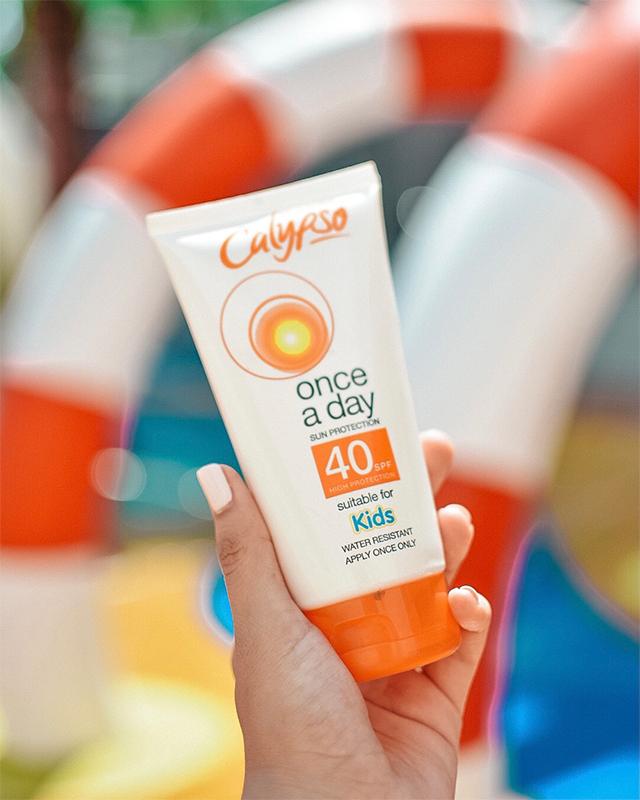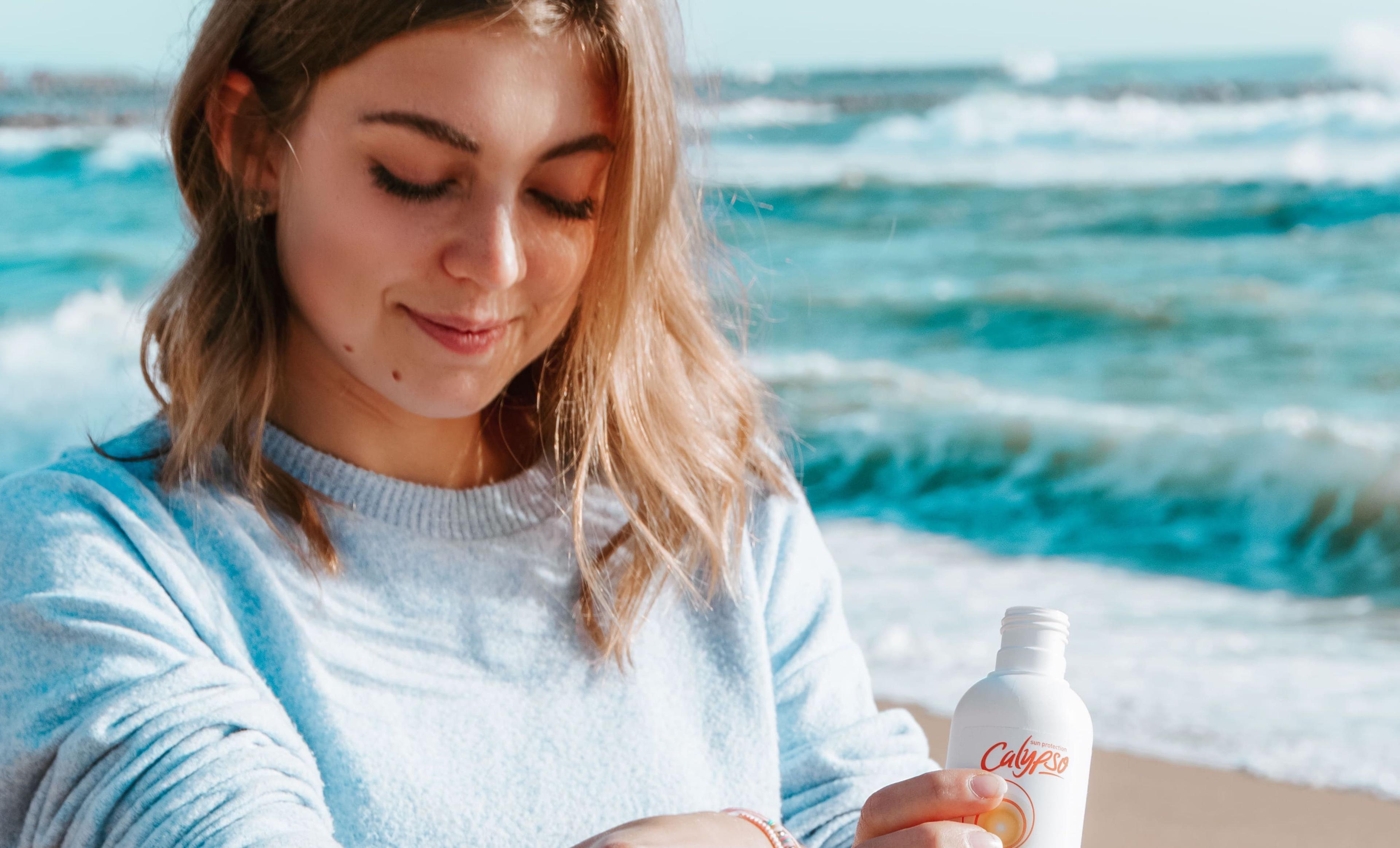Your cart

Sign up to get 10% off your first order
- Exclusive offers
- New product launches
- Sun advice
By entering your email, you are opting in to receiving emails from Calypso. You can opt out anytime.Privacy policy

Frequently Asked Questions
How does skin actually tan?
Do high factor sun creams give you less of a tan?
Do children need to have sun cream applied more frequently than adults?
Children are more susceptible to UV-related skin damage than adults. We obtain most of our lifetime's sun exposure as children and teenagers. It is known that sunburn during childhood can lead to severe skin damage in later years. You should use a specially formulated high factor product for children, such as our Once a Day SPF40 or our Sensitive Sun Lotion Spray SPF50+ and ensure it is re-applied, especially after swimming and towelling. Ideally, children should be covered up with loose clothes and wide-brimmed hats. Most importantly, children under 6 months should be kept out of direct sunlight.
Can I get a tan without UV radiation?
Sunless tanners and bronzers are applied to the skin and can provide a temporary, artificial tan, either by staining the skin or by compelling the skin to produce melanin. Make sure to read their labels to find out if they provide any sun protection.
What do SPF levels actually mean?
SPF stands for Sun Protection Factor and represents the sunscreen's ability to protect your skin from the sun's rays in addition to your skin's natural protection. Depending on your skin type, hair colour, eye colour and location, you may be able to stay in the sun for 10 minutes without burning.
If you apply a sunscreen with SPF30 this means that you can stay in the sun 30 times longer than you could without sunscreen. However, you must use sunscreen as directed and ensure enough sunscreen is initially applied (35ml) for maximum coverage. Higher factors should not be used to increase your time in the sun, but to increase your level of protection.
What is Aloe Vera?
Aloe Vera is a substance found in the leaves of an Aloe Vera plant; traditionally known for its soothing, healing and hydrating properties. The leaves of the Aloe Vera plant contain a clear gel that is used as a topical ointment. Surrounding the gel is the green part of the leaf that can be used to produce a juice. When used in a cream, Aloe Vera delivers superior moisturisation for dry and damaged skin, including sunburnt skin, due to its soothing properties.
When in a thick gel formulation, Aloe Vera eases the pain caused by cuts, burns or insect bites, when rubbed in gently. Calypso After Sun Aloe Vera Gel uses Aloe Vera to calm skin after time spent in the sun.
Do I need to apply sun cream when it is not particularly sunny or hot?
Yes, sunscreen is still required. Even when the sky is overcast, UV radiation levels are still at 80% of their normal levels. The temperature can be deceptive - a breeze can keep you cool, but it doesn't affect UV levels. Look up the UV index for your area to make sure you're using protection when you need to be.
Do I need to apply sun cream when its sunny in the UK?
Most definitely. Sun cream is not just for people who go on holidays to warm countries. We recommend adults and children to use sunscreen with a minimum of SPF30 in the UK.
Do Once A Day sunscreens really work for the whole day after a single application?
Yes! They keep their effectiveness by binding more strongly to the skin, so they last longer. Our Calypso Once A Day range is rigorously tested to ensure that even after 8 hours of wear, it still offers the SPF on the label. You should be extra careful to apply enough of the product and make sure all exposed skin is covered. However, please remember that even water-resistant Once A Day sunscreens can still be washed off if you spend a long time in the water or if you dry yourself with a towel, so you might need to reapply.
Are your products tested on animals, and are they suitable for vegetarians and vegans?
We're pleased to say that we don't test any of our products on animals. What's more, we don't buy ingredients that have been tested on animals by another manufacturer, so you can buy Calypso, confident in the knowledge that your sun care is cruelty-free.
All of our products are suitable for vegetarians. However, some contain ingredients like keratin (made from sheep's wool) or beeswax (made by bees) that vegans may wish to avoid.
Most of your sunscreens are water resistant, but what does that mean? Do I need to reapply sunscreen after swimming?
What is UVA radiation? Does Calypso protect me against UVA?
There are two types of ultraviolet radiation which can harm our skin UVA and UVB. Only UVB causes burning, but both types damage our skin, so good sunscreens should protect against both. However, SPF only measures UVB protection, so you have to check to make sure your sunscreen offers UVA protection too. There are lots of different UVA measuring systems around the world. We use the European standard look for the letters UVA inside a circle. This symbol means that a product meets the EU-recommended level of UVA protection.
Why does Calypso not display the UVA star rating on its packaging?
Calypso SPF products meet all UVA and UVB standards and are rigorously tested to ensure their effectiveness. The star rating system was designed by Boots (retailer) and is not recognised as industry standard, nor is it regulated.
The letters "UVA" inside a circle is a European industry standard marking, which is contained on all Calypso products.
I have allergies. Are Calypso products safe for me?
Allergies can be very serious, and we try to minimise potential allergens where possible. However, if you have an allergy to a particular ingredient, you should check the ingredients list before using the product. Always test new products on a small area of skin 24 hours before you first use them. You should do this even if you don't have any allergies.
Can I use Calypso products during pregnancy?
Yes you can. All ingredients in the Calypso product range have been approved as cosmetic ingredients.
What is the alcohol content of Calypso Hand Hygiene gel?
Why is alcohol the main ingredient in most hand sanitisers?
Alcohol, also known as ethanol, is the ingredient that kills bacteria and enveloped viruses.
Is Calypso Hand Hygiene gel anti-bacterial?
Will Calypso Hand Hygiene gel work against viruses?
Calypso Hand Hygiene Gel has been tested successfully under BS EN 14476 to kill viruses.
Can I use Calypso Hand Hygiene gel to disinfect objects?
It has not been designed for this purpose but will be of benefit and functional in killing bacteria on objects.
Does hand sanitiser expire?
Do you ship Hand Sanitisers abroad?
Unfortunately due to shipping restrictions, we can offer UK deliveries only (excluding Guernsey, Jersey, Isle of Man and Shetland Islands).
What is DEET?
DEET is an active ingredient used in many insect repellent products. When used correctly it leaves a barrier on the surface of the skin which deters biting insects from your skin.
What is the difference between 'Insect Repellent with DEET' and DEET free?
The difference between the products is that one contains the active ingredient DEET. Please refer to the question 'What is DEET?' to learn more about the ingredient. Our 'Insect Repellent Spray with DEET' lasts for up to 6 hours and our 'Insect Repellent DEET Free' lasts for up to 5 hours.
Are your Insect Repellents safe for children?
Our insect repellent products have different instructions for use on children. The Insect Repellent with DEET is not recommended for children under 6 years old and the 'Insect Repellent DEET Free' is not recommended for children under 2 years old. Please read the directions for use carefully for facial application and ideally complete a patch test before use.
Does the 'After Sun Lotion With Tan Extender' contain fake tan?
This product does not contain fake tan. The lotion and tan extender work together to prolong your natural tan by hydrating and stimulating melanin within your skin, helping ensure an even suntan after sun exposure.
Is the Scalp Protection suitable for dyed hair?
We believe the product will not directly affect dyed hair. However, as there are many types of dye systems, we ask you to apply with caution and to test a small part of the head / hair first, if possible.
Can I use it under makeup?
Absolutely! Our face sunscreens are all suitable for wearing under makeup. Apply your sunscreen first and allow it to dry completely before applying makeup for a smooth finish.
What are the benefits of Vitamin C?
Does this product contain fake tan?
This product does not contain fake tan. Instead, it features a tan enhancer formulated to accelerate and extend your natural tan, helping you achieve a radiant glow.
How much percentage of DEET does it contain?
Calypso Insect Repellent with Deet contains between 20-25% of Deet.
How does it work?
Do I need to rinse it off?
No, Calypso Natural Summer Glow Self-Tanning Water is a leave-on formula. Allow it to dry completely after application and avoid showering or getting wet for several hours to allow the tan to develop.
How often should I use it?
How does it work?
What kind of tan will I get?
This lotion is designed to provide a subtle, natural "summer glow" that gradually deepens with daily use.
Can I use this on my face?
Does it offer sun protection?
No, Calypso Natural Summer Glow Self Tanning range does not contain SPF and will not protect your skin from the sun's harmful UV rays. Always wear a separate broad-spectrum sunscreen when exposed to the sun.